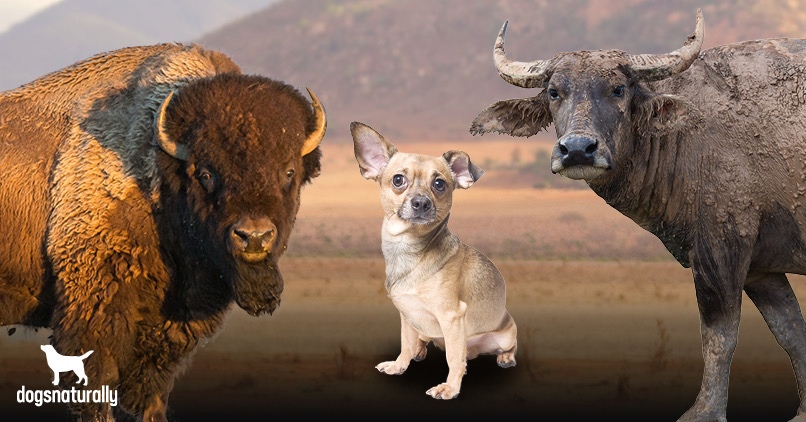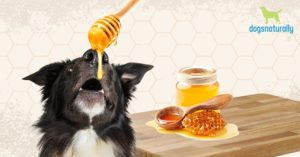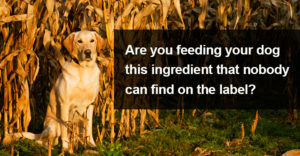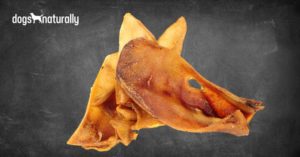Does your dog food ingredient label say it contains buffalo meat?
If so, you might not be feeding your dog what you think you are!
For several years now, “buffalo” has been an ingredient in quite a few dog foods.
The correct name for what most of us picture as a buffalo is “bison” (Latin name Bison bison). They’re the big, wild critters that roamed the American West in the tens of millions … before they were almost wiped out by indiscriminate hunting.
Let’s look at a bit of buffalo history.
The American Buffalo
The term “buffalo” as used in the Americas originated with French trappers. They referred to them as bœufs, meaning cow, ox or bullock.
The Lakota Sioux called them tatanka, but as settlers moved west, they and many Native American tribes described the animals as buffalo.
To Native Americans, buffalo are sacred. They once depended on bison for virtually everything … from food to clothing to shelter. Tribes have used the word buffalo since at least the 1600s. It predates the use of bison for the same animals by 150 years.
The “Other” Buffalo
In the rest of the world, though, the word “buffalo” conjures up quite a different animal.
That animal is usually the water buffalo (Latin name Bubalus bubalis). It’s a far more placid beast that’s common in India, China, and Southeast Asia.
Water buffalo were domesticated in Asia many thousands of years ago. They were brought to the Middle East and Egypt around 600 CE (AD) … and to Europe after the Crusades. In the last century, they arrived in South America, where they now thrive.
The US didn’t import its first water buffalo until the 1970s.
Water buffalo has some useful qualities:
- Due to their mild temperament, water buffalo are easy to raise.
- Their meat is as lean as bison, and taste tests show it compares favorably with beef.
Bison has some pros and cons:
- Bison meat is also very lean.
- It’s popular in health food stores, restaurants. You’ll even find it in regular grocery stores.
- Bison are more difficult than water buffalo to raise due to their undomesticated nature and slow growth. (It takes six to 12 months longer to raise bison to market weight than cattle). So bison products tend to be very expensive.
But … buyer beware! At the moment, it’s perfectly legal to market water buffalo as just “buffalo.”
Buffalo In Dog Food
Manufacturers have been happy to let American pet food buyers hang onto their Dances with Wolves illusions of bison roaming the Great Plains.
AAFCO (Association of American Feed Control Officials) is the organization that sets labeling and nutritional standards for animal feed, including pet food.
AAFCO recognized this buffalo confusion in 2018. So they formed a Buffalo/Bison Workgroup to examine the issue and recommend action.
I was a member of this Workgroup. Other members included:
- AAFCO state and federal members
- Representatives of the National Bison Association
- Representatives of the InterTribal Buffalo Council
- Pet food manufacturers
- Pet food consultants
- Retailers
- Pet food ingredient suppliers
The Workgroup met several times, mostly by phone conference. Meetings got a little contentious at times!
Initially, most stakeholders wanted to be able to call their products buffalo, no matter which species it was.
- Bison producers wanted to be able to call their products (but no one else’s) buffalo.
- Suppliers of water buffalo products were keen to maintain the status quo, and not have to disclose the truth about what they were selling.
Eventually the group decided to abandon the word “buffalo.” So they (we!) created separate nomenclature with specific required language.
- Products from water buffalo would be called water buffalo
- Bison products could be called either bison or North American buffalo
AAFCO passed the new feed terms and definitions. They’ll be published in the 2021 AAFCO Official Publication (OP).
So that means the changes won’t happen right away. Manufacturers have a bit of leeway.
When Will The Labeling Change?
After publication in the OP, the new terms will be technically enforceable … but not 100%. That’s because companies with a back stock of product and labels on January 1st, 2021 can delay the change until those stocks run out.
So you can expect these companies to do a lot of December purchasing … so they can eke every last dollar out of their deceptive labeling!
Meanwhile, you can expect that any pet product labeled simply as “buffalo” is likely to be water buffalo … and not bison.
As you read your dog’s food label, here are some things to keep in mind.
Read All The Ingredients!
Manufacturers have lots of ways to trick you … but if you look carefully you can see what they’re up to.
For example, one dog food lists buffalo first on its label, but it also lists bison further down. They’re clearly distinguishing between the two … and their label means water buffalo, not bison, is the main meat ingredient.
Brand Name Is Meaningless
Don’t be misled by marketing terms!
Just like “Nature’s” and “Natural” as brand names don’t mean that ingredients meet the official AAFCO definition of natural … “Buffalo” in the brand name is just marketing. It doesn’t mean buffalo meat is in the food.
There are two other issues to consider when it comes to this whole mess.
How The Animals Are Raised
I live in Colorado, where it’s not unusual to see bison out on pasture. In fact, I drive by a herd on my way to and from the grocery store!
It’s what most of us picture: big, shaggy beasts wandering across acres and acres of prairie, eating a natural forage diet.
Nearly all bison start life on pasture and stay there for 18 months or so. After that, there are 3 main ways bison come to market:
#1 – 100% Grass Fed
A minority of bison are 100% grass-fed. They’re born, live, and are harvested and processed in or close to the fields.
- Because it costs more to raise them, and demand outpaces supply, they fetch a premium price.
- Some of them are cull cows; they spend their entire lives on pasture, and when their reproductive days are over, they go directly to a slaughter facility.
#2 – Finished In Feedlots
A substantial number of bison spend their last 3 to 6 months in feedlots, where they’re fed an unnatural diet of grains, concentrates and supplements … just like factory-farmed cattle.
- Bison need more square footage per head than cattle
- The USDA prohibits the use of growth hormones
- Industry protocols don’t allow antibiotics to promote growth like they do in cattle
But otherwise it’s the same scene.
#3 – Something In Between
There’s also a middle ground that many producers choose.
- The bison stay on pasture, but they’re given supplementary grain rations
- This allows producers to call their animals “grass-fed” or “pasture-raised”
The advantages to grain-finishing lie mainly in taste of the meat and consistency of product.
It’s not just about pet food ingredients. If you prepare your dog’s raw diet yourself … you need to know about the human food standards too.
Buffalo Meat For Humans
Human food has much the same problem as dog food.
The definitions used by the US Department of Agriculture (USDA) are confusing.
- Bison can be called either bison or buffalo.
- Water buffalo processed under USDA inspection must be labeled water buffalo.
- But products produced outside a USDA-inspected facility* can simply be labeled as buffalo.
*That’s allowed, because buffalo are considered game animals. But don’t worry, 99% of all animals are still inspected, either by USDA or an equivalent system.
Changes Are Coming
The Truth in Buffalo Labeling Act has been recently introduced to resolve this confusion. (There are two retail chains in the eastern US that market water buffalo in this misleading way.)
This Act will amend Section 403 of the Federal Food, Drug and Cosmetic Act to require all Bubalus products to be labeled as water buffalo, while Bison products can be labeled as bison or buffalo. In other words, any product called “buffalo” (with no qualifier), must come from bison.
This serves two purposes.
- It will protect Native American groups and bison producers who have built their reputations on the name “buffalo.”
- It will assure US consumers that they are truly getting what they think they’re getting when they buy buffalo or bison products.
Once the bill is passed and signed into law, it still has to go through an FDA rulemaking process. So the Act won’t be immediately enforceable. However, it is certainly a step in the right direction.
For more information, including a listing of bison retailers and associated organizations, as well as further details about the water buffalo issue, visit the National Bison Association,
It’s disheartening to realize how these deceptive practices are being used in dog food marketing. It’s hard enough to find reputable, good quality brands as it is.
But as always, knowledge is power. Use it wisely!













